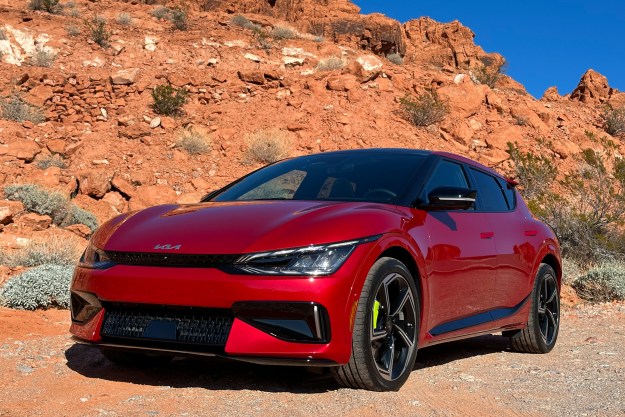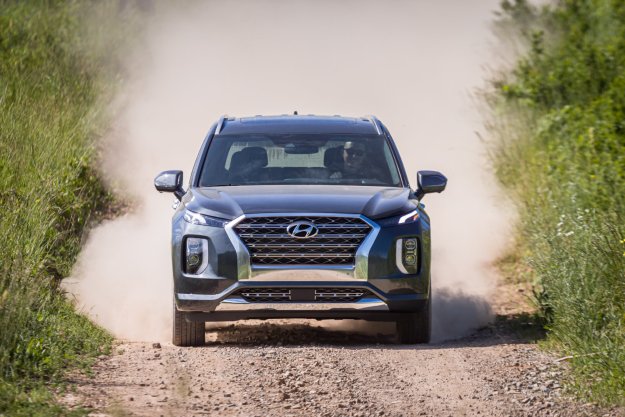
“The 2020 Hyundai Palisade is a value-conscious people-mover that punches above its price range.”
- Class-leading interior room
- Comfortable, competent ride
- Great value, especially in higher trim levels
- Lots of standard features, including tech
- Only one engine option
- Semi-autonomous driving functions lack future-proofing
The three-row crossover and SUV segment is one of the key battlegrounds in the current war of automotive attrition. As industry-wide sales volumes continue to decline, automakers are doubling down on producing competitive entries in segments like this one to secure market share and maintain profitability.
Some manufacturers were in a better position to tackle the consumer pivot to crossovers and SUVs than others. Hyundai found itself on the losing end of that equation for several years. While its sedan and small-car-heavy lineup was its salvation during the recession, that strategy became a liability as the recovery prompted buyers to go big again.
Over the past two years, Hyundai has rallied. By both improving its existing product and introducing impressive new models (such as the Hyundai Kona), the Korean powerhouse is returning to its decade-old stride.
The 2020 Hyundai Palisade is the pinnacle of that shift. This three-row crossover, available in seven and eight-passenger configurations, sits atop the Hyundai lineup as its most comfortable, feature-rich and family-friendly offering.
The Palisade comes in three trims. The $31,550 SE comes standard with eight-passenger seating. The $33,500 SEL model can be had with second-row captain’s chairs or the standard bench (for no charge) and adds safety and convenience features. The top of the range is the Limited, which bakes in everything available on the SEL and adds some exclusive niceties. Limited tops out at $44,700 and packs a ton of value at that price point. All-wheel-drive is available on every model.
Interior and exterior design
It’s important to note that the Hyundai Palisade shares a great deal of its underlying body structure and mechanical layout with its corporate sibling, the also-new Kia Telluride. Both are built using the same platform architecture and utilize the same engine and driveline.
While there are inevitable similarities in their proportions, it’s important to note that the Palisade and Telluride were designed, inside and out, by entirely independent studios. Think of it as two sculptors starting with identical chunks of marble but with completely different artistic visions.
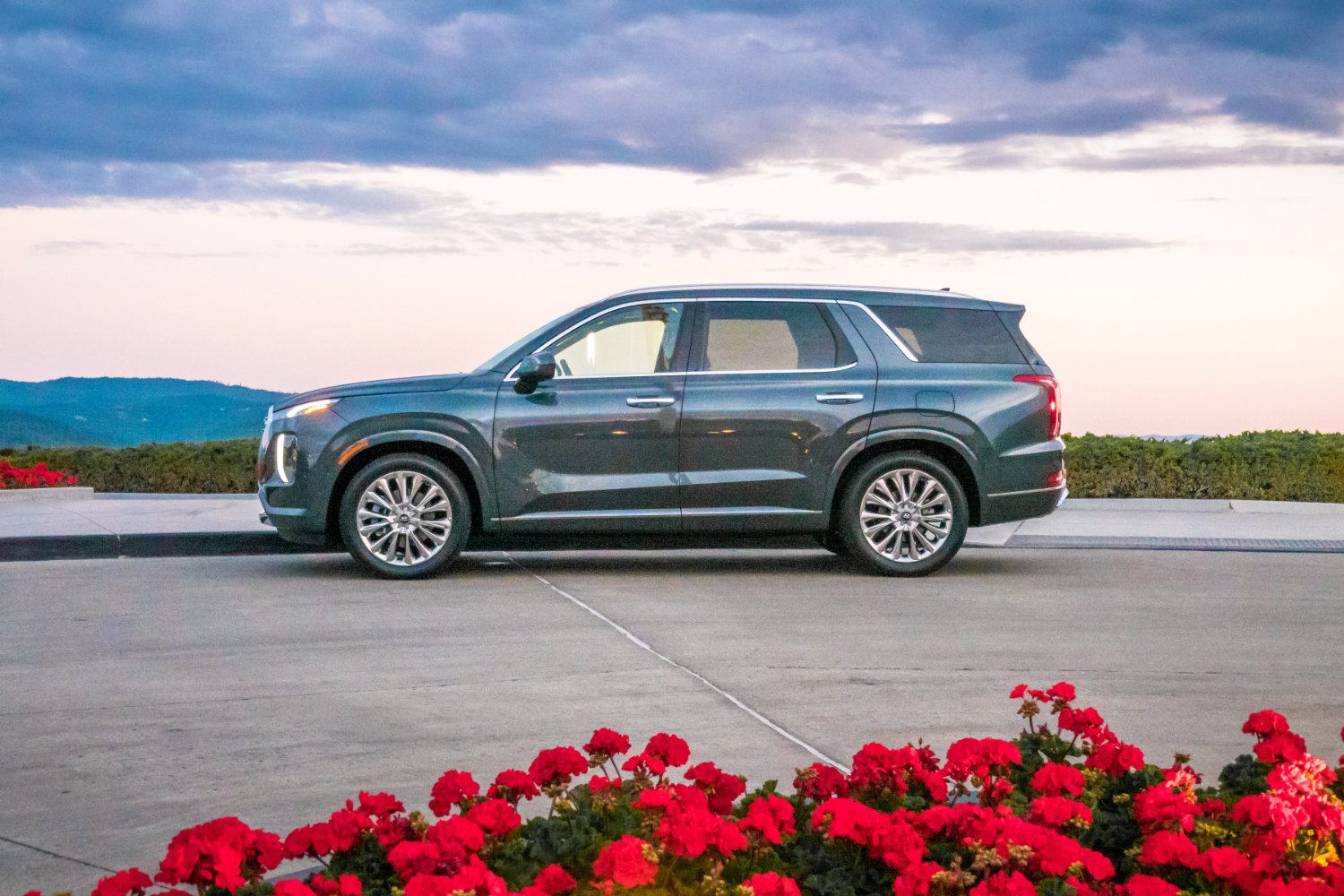
Hyundai’s design team wanted something bold and strong, but with an underlying elegance that belies its value-oriented pricing. Senior Chief Designer Chris Chapman walked us through the Palisade’s exterior design, explaining the emphasis his team placed on interlocking and interweaving elements.
Prominent examples include the headlight and fog-lamp elements up front, which run “under” the bumper cover, making it appear that the body elements have clamped over the lights. On the Palisade’s flanks, the chrome trim pieces around the window terminate at the C-pillar and do not meet. This intentional trick is an example of the interlocking theme, as the lines form two hooks. Out back, we see the contiguous lighting trick yet again, with the lower reflector and lighting trim appearing as a continuation of the inner tail lamp housings.
Hyundai’s design team wanted something bold and strong, but with an underlying elegance that belies its value-oriented pricing.
Inside, the themes are more subtle. Our Limited-trim test models featured Nappa leather seating and leatherette trim elements (including quilted inserts in the doors) for an upscale, elegant look. Aluminum-finish trim pieces tie together the center console with the wings of the dashboard and the door speaker grilles on the Harman Kardon premium audio system. The Palisade’s push-button, shift-by-wire transmission allows for a floating center console with a large storage bin underneath.
Unlike the Hyundai Santa Fe XL it usurps, the Palisade boasts 18 cubic feet of rear cargo space even with the third-row seats deployed. Drop the third row and that increases to an impressive 45.8 cubic feet. Vehicles equipped with the second-row captain’s chairs also offer quite a bit of space in the aisle between those seats for road trip accessories such as small coolers, tote bags or backpacks.
Tech features
Building an attractive, comfortable car is only part of the equation when it comes to winning over family shoppers in today’s marketplace. Tech is important, and Hyundai has embraced that paradigm. The Palisade SE comes standard with an 8” touchscreen interface with Android Auto and Apple CarPlay integration (which, by necessity, includes USB connections) and a monochrome cluster information screen. Standard driver aids include forward collision detection and braking assist (including pedestrian detection), lane keeping assist, a driver attention monitoring system and rear occupant alert. Wireless device charging is also available for those with enabled smartphones.
Stepping up to the SEL allows you to option the convenience package, which adds third-row USB outlets (bringing the total to seven in a 3+2+2 configuration), a seven-inch multi-function cluster display and a hands-free smart liftgate. Blind-spot monitoring with collision avoidance assist, rear cross-traffic detection with avoidance assist and safe exit assist (which keeps doors secured when rear passengers attempt to exit while a vehicle is approaching from the rear) are also included.
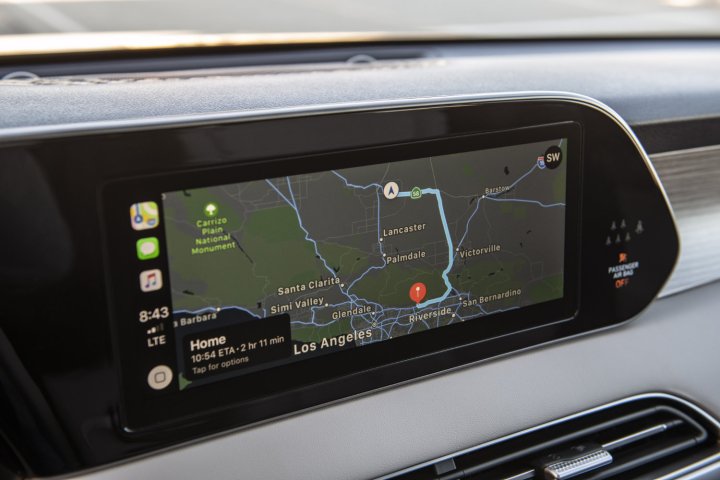
Limited models, such as our test examples, take the driver information system to the next level. A full, 12.3-inch digital cluster replaces the analog gauges and seven-inch display complemented by a HUD. The 630-watt, 12-speaker Harman Kardon audio system is also standard at this level. Limited models also feature a 360-degree camera system and blind view monitor, which projects images from blind spot monitoring cameras into the cluster display when turn signals are activated.
Optional on SEL (as part of the Drive Guidance package) and standard on Limited is Hyundai’s new Highway Driving Assist (HDA) system. This adds another layer of intelligence to Hyundai’s semi-autonomous features. If a driver sets the cruise control target speed to match the speed limit on a U.S. interstate, HDA will adjust to changes in the speed limit without driver intervention. If a speed other than the posted limit is chosen, the system will remain in standby mode and defer to the driver’s choices.
The beauty of the Palisade is that its value proposition actually improves as you go up in trim level.
This system is convenient and functions well enough within its limited scope, but it’s worth noting that it is dependent on the navigation system’s speed limit database, which means that must be updated in order to keep information current. It cannot read road signs dynamically, so it will not adjust to construction zones or other temporary speed restrictions (such as interstates with dynamic speed limits). This lack of future-proofing isn’t a complete deal-breaker, but it limits the attractiveness of a feature with an already-narrow use case.
Additional family-friend features include standard Quiet Mode, which silences rear speakers for sleeping kiddos, and an optional driver talk intercom (SEL and above) which amplifies the driver’s voice to better reach third-row occupants.
Driving impressions
All Palisades are powered by a 3.8L V6 producing 291 horsepower and 262lb-ft of torque. Power goes to either the front or all four wheels via a conventional eight-speed automatic transmission with push-button gear selection and shift-by-wire and wheel-mounted paddle shifters. A five-option drive mode select system is also included, allowing the driver to choose between Comfort, Eco, Sport, Snow and Smart. Comfort is the equivalent of “normal” for this system, while Eco alters the throttle and shift programming for maximum efficiency. Sport shifts those curves the other direction and tightens up the steering effort for more immediate, direct responses to driver inputs.
Smart mode will select dynamically between Eco, Comfort and Sport programs (less Sport’s steering attributes) depending on driver inputs and road conditions. Snow mode is specifically for low-traction situations and only activates when deliberately selected.
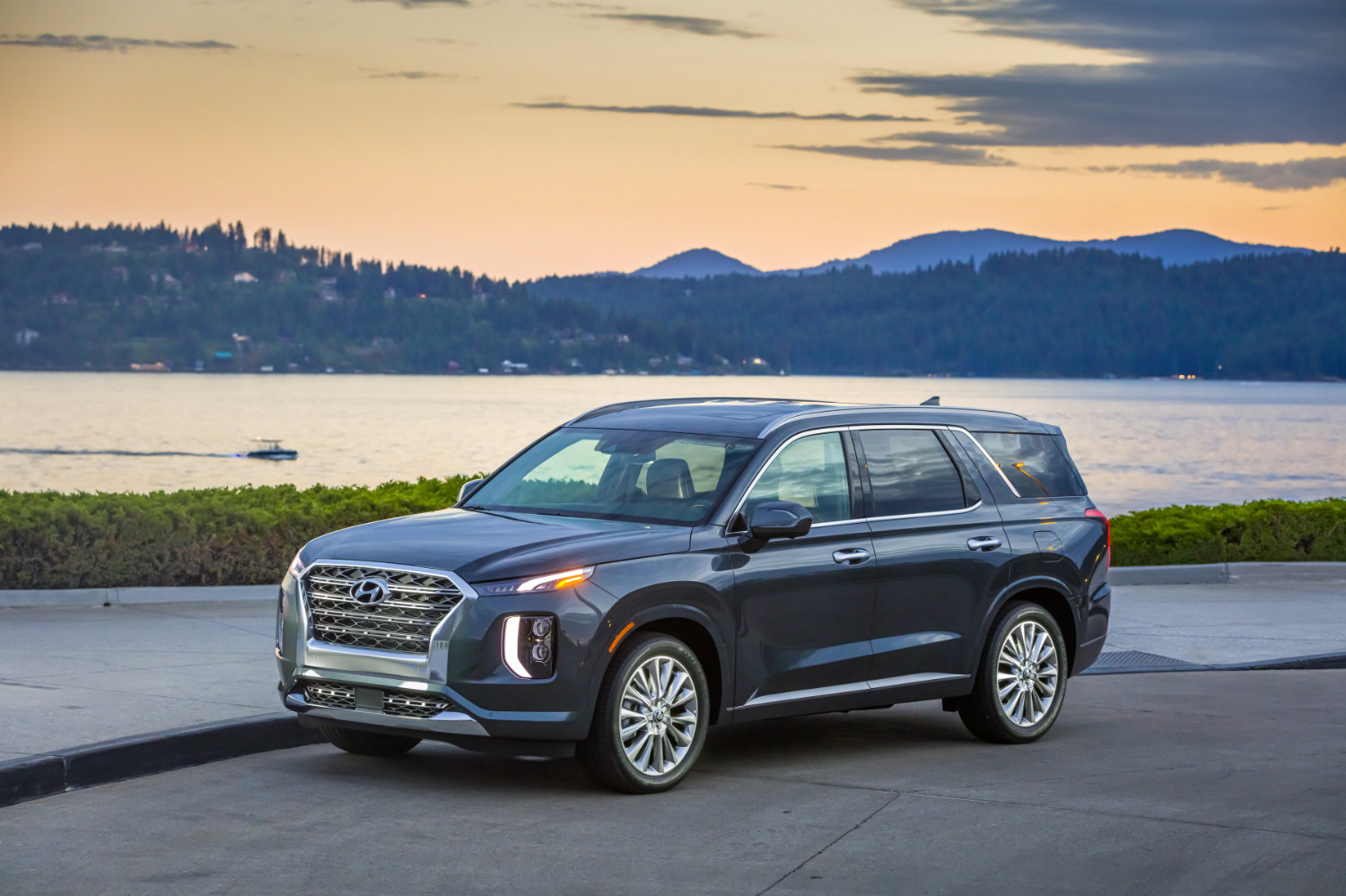
We played around with the four relevant modes (Comfort, Smart, Sport and Eco) on the road and found them all to be quite intuitive. Our preference was for either Comfort or Sport, usually for the former’s unobtrusive behavior and the latter’s almost perfectly tuned steering weight, which isn’t incorporated into Smart mode.
The Palisade’s MacPherson Strut front suspension and self-leveling rear setup make for an excellent ride with reflexes sharp enough to handle the winding roads of North Idaho with little drama. SE and SEL models come standard with a fixed-height, multi-link rear suspension, which should behave just as well as this optional upgrade. The self-leveling suspension’s true value is seen only when hauling heavy loads or towing. Max trailering capacity for the Palisade is 5,000 pounds. That doesn’t require any optional packages, since Palisade comes standard with a heavy-duty transmission cooler and trailer harness pre-wiring.
The Palisade is rated at 19 mpg city, 26 highway and 22 combined with front-wheel-drive. Adding all-wheel-drive drops those figures to 19/24/21.
The competition
In pricing the Palisade, Hyundai picked out a handful of targets as the Palisade’s primary competition. They include the Ford Explorer, Volkswagen Atlas, Honda Pilot and Subaru Ascent. This is just a slice of the segment, of course, but based on the Palisade’s feature content and price range, the two most direct competitors are the aforementioned Subaru and the vehicle Hyundai is least interested in mentioning: the Kia Telluride.
Loaded up, all three price out within just a few hundred dollars of each other. The Ascent lacks the Hyundai’s digital cluster and dual-panel sunroof. Both it and the Telluride give up the convenience of a power-folding third row. The Palisade also boasts more USB outlets than the Ascent and has a larger infotainment screen. Hyundai and Kia also beat Subaru’s five-year, 60,000-mile warranty.
This is a narrow view at a very large segment, but with Subaru pulling ahead of Hyundai in volume over the past year, it’s easy to imagine that the latter’s executives have painted a large bullseye on the all-wheel-drive automaker’s back.
Peace of mind
Hyundai’s 10-year, 10,000-mile powertrain warranty is known industry-wide for being one of the most generous. The company’s reliability record has been reasonably good since its product renaissance of a decade ago, so customers likely won’t need to make much use of it.
Hyundai also included several feel-good items as either standard or optional features, like rear-seat occupancy alerts which can be sent directly to owners’ smartphones via the Blue Link app.
In addition to the driver aids we mentioned above, the Palisade comes standard with trailer sway control for towing situations and a lengthy list of air bags and other typical passive safety features. The second row is equipped with two LATCH anchors and three tethers (regardless of seating configuration) and the third row offers one LATCH anchor and two additional tethers.
How DT would configure this car
The beauty of the Palisade is that its value proposition actually improves as you go up in trim level. The sweet spot for Palisade is the SEL trim level. For those who plan to use the Palisade’s full seating capacity often, this opens up the Premium package for the power-folding third row. For those who expect to tow a lot, the Convenience package can be added to nab the auto-leveling rear suspension.
If we’re going for tech above all else, it’s hard to argue with the Limited, which still checks in thousands of dollars cheaper than the likes of a loaded-up Chevrolet Traverse, Honda Pilot or Volkswagen Atlas.
Conclusion
The 2020 Hyundai Palisade is an exemplary vehicle from a brand that knows how to reinvent itself. In addition to the Kona and the forthcoming Venue, it will be a significant shot in the arm for Hyundai’s credibility (not to mention its sales) in the U.S. market. It offers a robust feature suite at a very competitive price that is backed up by one of the industry’s best warranties.
If you’re shopping for a three-row SUV, put the Hyundai Palisade on your short list.
Editors' Recommendations
- 2025 Hyundai Tucson Plug-In Hybrid gets improved tech features
- Amazon and Hyundai partner on online car sales, in-car services
- Mercedes-AMG EQE SUV first drive review: a better electric SUV
- Mercedes-Benz EQE SUV first drive review: ’90s look, cutting-edge tech
- Hyundai Ioniq 6 first drive review: welcome to the future



